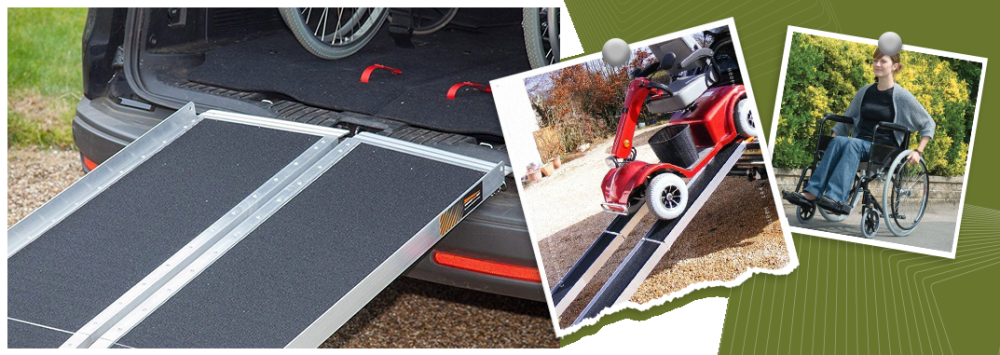
Keeping on the Move with Mobility Aids
Sally Madeley-Carr, OT31 Mar 2022
A special aid is a piece of equipment that allows a person with a disability to perform a task equally to a non-disabled person who does not need that piece of equipment.
In the case of individuals who have mobility difficulties, their level of need will depend on their own personal difficulty with mobility and their aspirations.
Age brings with it a weakened frame and so general weakness, balance and standing may no longer be independent tasks, as bad backs, arthritis and long term conditions such as Parkinson's disease make 'once taken for granted' movement and mobility become a little more difficult to perform.
Everyday tasks in the home may call for one type of special aid, whilst being out and about may call for different supporting aids.
Handling Mobility in the Home
Mobility difficulties will affect almost all tasks carried out in the home. For example:
- moving from room to room
- using the toilet and bathing facilities
- using the kitchen
- climbing stairs
- getting to the door, if someone knocks
- tasks such as ironing, hanging up clothes and housework
- general independence.
Handling Issues Inside the Home
Some of the walking support available to get you from one place to another inside your home can come in the form of walking canes, walkers and grab rails.
A walking cane gives support to one side of your body i.e. if your left hip, leg, or foot is not currently giving you full support, holding the cane on the same side of the body teams up with that weakness to give extra support when that side of the body needs to bear weight.
A walking cane takes up no space and can make walking remain comfortable and still an independent task.
A walker is a waist-high framework placed in front of the user, which the user lifts forward about twelve inches (30 cm) and then steps up to it, moving the frame again for the next step forward.
A walking frame gives added support to the lower body, as the shoulders and arms take some of the weight off the hips, legs and feet.
A walker with wheels has the same effect as a walking frame, though it has the added advantage of not needing the user to lift the frame forward but simply to push it into motion. Individuals with limited upper body strength will find the walker with wheels more suitable than the model without wheels.
Walking frames and walkers with wheels work well on even surfaces but meet difficulties on uneven ground.
For individuals who have balance problems, grab rails located at appropriate points can allow the individual to move around the room (e.g. the kitchen or bathroom) with comparative ease.
When it comes to carrying items (e.g. a drink, a meal, or some other item, from one place to another), a food trolley can steady the item(s) for transportation.
Whilst a food trolley is not a mobility aid, it can help keep independence at the forefront of the user's day-to-day tasks.
Mobility Outside the Home
Once you're outside the door of your home, mobility difficulties present themselves once again e.g. getting from the front door to where you want to be e.g. the car, bus stop, shop, appointment, restaurant etc..
Whilst walking canes and walkers and, to a limited extent, grab rails located appropriately, might make mobility still manageable in the garden or back yard, longer distances may call on the need for a wheelchair as a mode of mobility-cum-transport.
Choosing the most appropriate wheelchair for the individual's needs will go a long way to allowing social activity and independence to work hand in hand.
A Wheelchair Fit for Purpose
A wheelchair can be used in the home but a lot depends on the size of the rooms, as extra space is needed for turning in a wheelchair (forward and reverse curved movements to complete a full turn).
In the kitchen, as well as in the bathroom, aisles will need to be wide enough to allow for turning and, in all rooms, door width may need to be somewhat wider than normal door-frames, to allow wheelchair access and egress.
The Prospective User's Needs and Desires
Whilst a young person may have a lot of energetic needs and desires and may benefit from a sport style wheelchair, a more senior person's desires might be not so adrenalin-focussed. Lifestyle is therefore the first point to be addressed when deciding which model best meets the user's needs and desires.
Manual Wheelchairs
A manual wheelchair is, as it says, manually operated, either by the user who will use their upper body strength to manoeuvre the chair via turning the wheels, or by another person in accompaniment, who will push the chair from behind.
Manual wheelchairs don't need batteries and so don't need to be regularly charged. They are therefore much lighter in weight than battery-operated models and so easier to transport.
Some designs of manual wheelchair use a hydraulic pump to raise the user to a standing position, which can, with its own built-in support, make the user feel more independent and in keeping with the crowd.
Wheelchairs have a user weight limit and so, for the much larger person, a heavy duty frame can cater for up to 350 lbs. (159 kilos) weight. Made with double cross braces, stronger tubes and heavy duty upholstery, such bariatric chairs are more durable.
The Folding Wheelchair
For the person who still has an active social life, a lightweight, folding wheelchair is a perfect choice for being out and about, though a sturdier wheelchair would be more suitable for day-to-day purposes.
Folding wheelchairs take up little space in a car and are fuss-free for handling, making it easy for whoever is responsible for assembling or disassembling the chair.
Powered Wheelchairs
Though much more expensive, a powered wheelchair moves more easily and does not rely on manual effort.
The battery in a powered wheelchair contributes a lot to the overall weight of this mode of transport, though it does make independence outdoors perfect for those who have upper body ability for steering.
When purchasing a powered wheelchair, be sure to check the battery's maximum mileage capacity, so as to be able to keep on top of charging the battery in times of need.
Charging overnight is the best time to get the battery up to full capacity but never leave the battery plugged in for long periods of time, as doing so will damage the battery and shorten its life.
Mobility Scooters
Mobility scooters are another popular mode of transport and come as both class 2 and class 3 models.
A class 2 model reaches a speed of four miles an hour and can be used on the pavement.
A class 3 model can reach a speed of eight miles an hour and is to be used on the road though, during practice runs, can be used at the lower speed of four miles an hour on the pavement.
Measuring Up
The human skeleton is not the same shape for all, so a person's measurements need to be taken, in order to purchase the right size wheelchair.
The suitable depth for an individual should guarantee support from the back of the pelvis to two inches (5 cm) before the bend at the knee. Any closer to the knee fold in the leg could constrict flow of blood circulation.
The width of a wheelchair should not be so wide that it doesn't support the user's body.
In the case of a manual wheelchair, the width should take into account the user's need to reach the wheels without stretching.
Personalising the Wheelchair
Accessorising a wheelchair will make it personal to the user, colour and designs indicating personality and interests.
Accessories will include seat pads, bags and pouches. Great thought should go into what is the best choice of bag and / or pouch, as greater independence will be evident if the user has personal access to his / her belongings.
A wheelchair table is a must, not only for eating and drinking but also for day-to-day activities.
Belts and harnesses give support to the wheelchair user and will be personal to that user's needs e.g. the need for upper body support, as well as pelvic support to promote a straight spine.
Summary
Later years bring changes to our independence and special aids can help us hold onto our independence for longer.
When choosing the most suitable mobility support for an individual, lifestyle and aspirations should be the leading factors in making the right choice.
Walking canes, walkers with or without wheels and also grab rails can make independent living still comfortably within the senior person's grasp.
Choosing the right means of support aid for outdoor use is the focal point. Personalising it will come later.
Though manual, a folding wheelchair can play its part in keeping the user socially involved, as it is fuss free, easy to store in a car and quick to assemble and disassemble.
The right seat depth and chair width, when complemented with appropriate belt and any identified need for a supportive harness, help hug the user, keeping them sturdy and safely comfortable.

Sally Madeley-Carr, OT
Sally qualified as an Occupational Therapist in 1996 and is a well-respected professional in the field of rehabilitation equipment and living aids. She has worked in private practice and within the NHS, developing a broad experience with adults and children. Click here for Sally's registration with the Health and Care Professions Council. The HCPC regulates health, psychological and social work professionals in the UK.